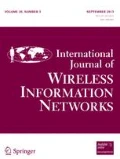Abstract
Aiming at the problems of low accuracy and efficiency and high false alarm rate in current network intrusion detection methods, a network intrusion detection method based on machine learning is proposed. Machine learning algorithm is used to classify network packets, and information gain is used as attribute selection measure to train and test multiple samples. Based on the principle of structural risk minimization, the optimal interval is obtained and the difference function is obtained. The intrusion detection framework is constructed by collecting network traffic data, system logs, user behavior information and host information. This paper establishes the evaluation index of machine learning network intrusion detection, analyzes and constructs the machine learning network intrusion detection model, preprocesses the data of intrusion detection model, uses random forest algorithm to learn and train the data, calculates the importance of features, reduces the data dimension, and realizes network intrusion detection. The experimental results show that this method has high accuracy and efficiency, and can effectively reduce the false alarm rate of network intrusion detection.







Similar content being viewed by others
Data Availability
All data, models, and code generated or used during the study appear in the submitted article.
References
T. H. Miller, M. D. Gallidabino, J. I. MacRae, et al., Prediction of bioconcentration factors in fish and invertebrates using machine learning, Science of The Total Environment, Vol. 648, No. 10, pp. 80–89, 2019.
M. Hajihosseini, M. Andalibi, M. Gheisarnejad, et al., DC/DC Power Converter Control-Based Deep Machine Learning Techniques: Real-Time Implementation, IEEE Transactions on Power Electronics, Vol. 35, pp. 9971–9977, 2020.
G. R. Mahajan, B. Das, D. Murgaokar, et al., Monitoring the Foliar Nutrients Status of Mango Using Spectroscopy-Based Spectral Indices and PLSR-Combined Machine Learning Models, Remote Sensing, Vol. 13, No. 4, pp. 641, 2021.
L. Grbi, L. Kranjevi and S. Drueta, Machine Learning and Simulation-Optimization Coupling for Water Distribution Network Contamination Source Detection, Sensors, Vol. 21, No. 4, pp. 1157, 2021.
B. Farsi, M. Amayri, N. Bouguila, et al., On Short-Term Load Forecasting Using Machine Learning Techniques and a Novel Parallel Deep LSTM-CNN Approach, IEEE Access, 2021. https://doi.org/10.1109/ACCESS.2021.3060290.
S. E. Zhang, L. Sehoole, M. S. D. Manzi, et al., Use of novel 3D seismic technology and machine learning for pothole detection, characterization, and classification—Case study in the Bushveld Complex (South Africa), The Leading Edge, Vol. 40, No. 2, pp. 106–113, 2021.
C. H. Lin, J. X. Wu, P. Y. Chen, et al., Symmetric Cryptography with a Chaotic Map and a Multilayer Machine Learning Network for Physiological Signal infosecurity: Case Study in Electrocardiogram, IEEE Access, Vol. 9, pp. 26451–26467, 2021.
W. Liu, Z. Tang, F. Lv, et al., Multi-feature integration and machine learning for guided wave structural health monitoring: application to switch rail foot, Structural Health Monitoring, Vol. 46, No. 1, pp. 147592172198957, 2021.
R. D. Costache, Q. B. Pham, E. Sharifi, et al., Flash-Flood Susceptibility Assessment Using Multi-Criteria Decision Making and Machine Learning Supported by Remote Sensing and GIS Techniques, Remote Sensing, Vol. 12, No. 1, pp. 106, 2020.
J. Liu, W. Zhang, Y. Chung, et al., Adaptive Intrusion Detection via GA-GOGMM-based Pattern Learning with Fuzzy Rough Set-based Attribute Selection, Expert Systems with Applications, Vol. 139, No. 5, pp. 112845, 2020.
Y. Wu, W. W. Lee, Z. Xu, et al., Large-Scale and Robust Intrusion Detection Model Combining Improved Deep Belief Network With Feature-Weighted SVM, IEEE Access, Vol. 8, No. 10, pp. 98600–98611, 2020.
W. Li and X. Tu, Quality analysis of multi-sensor intrusion detection node deployment in homogeneous wireless sensor networks, The Journal of Supercomputing, Vol. 76, No. 12, pp. 1331–1341, 2020.
X. Zuo, Z. Chen, L. Dong, et al., Power information network intrusion detection based on data mining algorithm, The Journal of Supercomputing, Vol. 76, No. 6–7, pp. 2899–2908, 2020.
R. H. Dong, H. H. Yan and Q. Y. Zhang, An Intrusion Detection Model for Wireless Sensor Network Based on Information Gain Ratio and Bagging Algorithm, International Journal of Network Security, Vol. 22, No. 2, pp. 218–230, 2020.
J. Ning, J. Wang, J. Liu, et al., Attacker Identification and Intrusion Detection for In-Vehicle Networks, IEEE communications letters, Vol. 23, No. 11, pp. 1927–1930, 2019.
R. Vijayanand and D. Devaraj, A novel feature selection method using whale optimization algorithm and genetic operators for intrusion detection system in wireless mesh network, IEEE Access, 2020. https://doi.org/10.1109/ACCESS.2020.2978035.
J. Guo, Design of Adaptive Marine Network Intrusion Detection and Dynamic Defense System, Journal of Coastal Research, Vol. 104, No. sp1, pp. 104–109, 2020.
Y. Song, B. Bu and L. Zhu, A Novel Intrusion Detection Model Using a Fusion of Network and Device States for Communication-Based Train Control Systems, Electronics, Vol. 9, No. 1, pp. 181, 2020.
S. Li, J. Xie, F. Zhou, et al., Foreign Object Intrusion Detection on Metro Track Using Commodity WiFi Devices with the Fast Phase Calibration Algorithm, Sensors, Vol. 20, No. 12, pp. 3446, 2020.
A. Almalawi, A. Fahad, Z. Tari, et al., Add-On Anomaly Threshold Technique for Improving Unsupervised Intrusion Detection on SCADA Data, Electronics, Vol. 9, No. 6, pp. 1017, 2020.
C. E. Graves, C. Li, X. Sheng, et al., Memristor TCAMs Accelerate Regular Expression Matching for Network Intrusion Detection, IEEE Transactions on Nanotechnology, Vol. 18, pp. 963–970, 2019.
C. Iwendi, et al., The Use of Ensemble Models for Multiple Class and Binary Class Classification for Improving Intrusion Detection Systems, Sensors, Vol. 20, No. 9, pp. 2559, 2020. https://doi.org/10.3390/s20092559.
S. Bhattacharya, et al., A Novel PCA-Firefly Based XGBoost Classification Model for Intrusion Detection in Networks Using GPU, Electronics, Vol. 9, No. 2, pp. 219, 2020. https://doi.org/10.3390/electronics9020219.
Author information
Authors and Affiliations
Corresponding author
Additional information
Publisher's Note
Springer Nature remains neutral with regard to jurisdictional claims in published maps and institutional affiliations.
Rights and permissions
About this article
Cite this article
Wu, F., Li, T., Wu, Z. et al. Research on Network Intrusion Detection Technology Based on Machine Learning. Int J Wireless Inf Networks 28, 262–275 (2021). https://doi.org/10.1007/s10776-021-00520-z
Received:
Revised:
Accepted:
Published:
Issue Date:
DOI: https://doi.org/10.1007/s10776-021-00520-z




